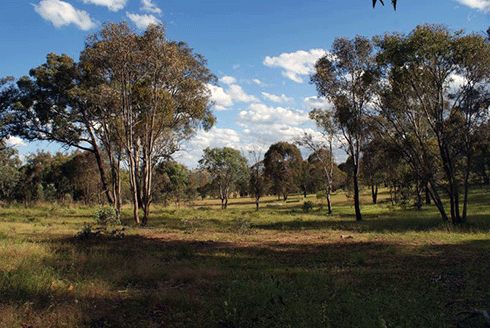
|
Published: 31 March 2014
Private land ‘can help save Australia’s imperilled wildlife’
Private land can help protect Australia’s endangered bird populations as effectively as the nation’s best performing conservation reserves, a new study shows.

|
|
Box gum grassy woodlands, such as this patch near Canberra, often co-exist with farmland in eastern Australia. This habitat supports more than 400 plant species and animals such as squirrel gliders, goannas, regent honeyeaters and bush stonecurlews. Credit:
Brett Howland
|
In the surprising discovery, researchers from the ARC Centre of Excellence for Environmental Decisions (CEED) and The Australian National University (ANU) have found that unprotected areas are faring far better than old conservation reserves as sanctuaries for the nation’s woodland birds.
This is because some private lands, when compared with old conservation areas, contain more flat and fertile habitats where woodland birds prosper, say Professor David Lindenmayer and Ms Laura Rayner of CEED and ANU. The finding indicates that unprotected areas have great potential to conserve and restore native wildlife.
‘Our study focused on Canberra’s protected areas, many of which were established prior to 1995,’ says Ms Rayner. ‘We found that while these long-established reserves are effective in maintaining woody vegetation cover, they are less effective when it comes to protecting woodland bird populations.’
Ms Rayner explains that when compared with private lands or reserves established after 1995, the older protected areas have fewer endangered birds as well as lower and declining species richness.
‘This is because many of the older reserves were created for their scenic value instead of biodiversity,’ says Ms Rayner. ‘Most were established on hilltops or ridges near to the urban centre, so woodland birds are unlikely to thrive in these environments.’
On the other hand, private, non-reserved areas that have high quality woodlands have been extremely effective in keeping the endangered birds, Prof. Lindenmayer says. ‘The endangered bird population in these areas is comparable with well-maintained newer reserves.
‘These private lands are also further from the city compared to protected areas, and many private landowners are enthusiastic about ensuring homes for the native birds.’
‘So as our cities grow, birds in the old reserves have even less chances of surviving due to disruptive noise or invasive land animals,’ Prof. Lindenmayer explains.
‘If we want to protect and save Australia’s endangered native species, we really need to look towards conservation and restoration on private lands, and more national parks that are actually suitable for woodland birds.’
In a separate study, CEED researchers have developed a model to determine where – and who – best to restore habitat for native reptiles and beetles cost-effectively.
Lead author Dr Sacha Jellinek of CEED and The University of Melbourne explains that the model integrates ecological and social data as well as expert opinion to predict the cost-effectiveness of restoring biodiversity on private lands.
‘We focused on agricultural land in northwest and northeast Victoria that has been cleared and gradually degraded for the past 150 years,’ says Dr Jellinek. ‘We found that it was most cost-effective to concentrate on revegetating cleared areas, rather than restoring degraded remnant patches or previously replanted areas.
‘In addition, we discovered that the type of restoration undertaken was very important. So for the same amount of money, you’re more likely to attract reptiles and beetles if you control weeds and add fallen timber, leaf litter and rocks in cleared lands, as well as plant trees and shrubs. The study shows this can increase beetle species richness by up to 23 per cent and reptile species richness by up to 12 per cent.’
The researchers also found that landowners who join Landcare groups or have off-farm incomes are more likely to undertake native revegetation, which may help to restore biodiversity on their lands. Professor Brendan Wintle of CEED and the University of Melbourne says this is one of the first biodiversity models to combine social with ecological data.
‘The model is useful because it takes account of the people involved,’ he says. ‘Whether it’s replanting in cleared or remnant lands, the success of any restoration effort on private lands is critically dependent on the enthusiasm, cooperation and motivation of the landowners.’
Prof. Wintle explains that the model can help government and conservation groups prioritise where to invest their funds: ‘It also quantifies what you can gain in biodiversity per dollar spent, which means you can use it to predict where and which landowners can bring you the best results.’
Dr Jellinek adds that it’s still important to encourage landowners who haven’t been involved in Landcare to restore biodiversity on their farms.
‘Many landholders are concerned that revegetation will attract pests and weeds or increase fire risk on their properties, so helping them to manage these risks may encourage them to revegetate and restore habitat for our native wildlife.’
Source: ARC CoE for Environmental Decisions (CEED)



